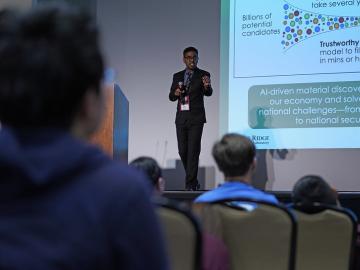Filter News
Area of Research
- Advanced Manufacturing (4)
- Biological Systems (1)
- Biology and Environment (87)
- Biology and Soft Matter (1)
- Building Technologies (3)
- Clean Energy (75)
- Climate and Environmental Systems (4)
- Computational Biology (2)
- Computational Engineering (2)
- Computer Science (7)
- Fusion and Fission (32)
- Fusion Energy (13)
- Isotopes (20)
- Materials (54)
- Materials for Computing (4)
- Mathematics (1)
- National Security (23)
- Neutron Science (60)
- Nuclear Science and Technology (28)
- Nuclear Systems Modeling, Simulation and Validation (1)
- Quantum information Science (1)
- Supercomputing (59)
News Type
News Topics
- (-) Artificial Intelligence (58)
- (-) Biomedical (39)
- (-) Buildings (36)
- (-) Critical Materials (13)
- (-) Environment (143)
- (-) Fusion (37)
- (-) Isotopes (31)
- (-) Machine Learning (31)
- (-) Neutron Science (73)
- (-) Nuclear Energy (71)
- (-) Physics (30)
- (-) Security (11)
- (-) Space Exploration (22)
- 3-D Printing/Advanced Manufacturing (66)
- Advanced Reactors (21)
- Big Data (37)
- Bioenergy (64)
- Biology (74)
- Biotechnology (13)
- Chemical Sciences (30)
- Clean Water (27)
- Climate Change (69)
- Composites (15)
- Computer Science (119)
- Coronavirus (28)
- Cybersecurity (17)
- Decarbonization (51)
- Education (1)
- Emergency (2)
- Energy Storage (59)
- Exascale Computing (25)
- Fossil Energy (4)
- Frontier (24)
- Grid (43)
- High-Performance Computing (53)
- Hydropower (11)
- Irradiation (2)
- ITER (5)
- Materials (75)
- Materials Science (75)
- Mathematics (6)
- Mercury (10)
- Microelectronics (2)
- Microscopy (31)
- Molten Salt (6)
- Nanotechnology (28)
- National Security (36)
- Net Zero (9)
- Partnerships (15)
- Polymers (17)
- Quantum Computing (23)
- Quantum Science (39)
- Renewable Energy (1)
- Simulation (36)
- Software (1)
- Statistics (1)
- Summit (36)
- Sustainable Energy (87)
- Transformational Challenge Reactor (3)
- Transportation (62)
Media Contacts

Leadership Tennessee has named Clarice Phelps to its 2024–2025 Signature Program Class XI to collaborate with professionals statewide to address Tennessee’s most serious issues.

An Oak Ridge National Laboratory team revealed how chemical species form in a highly reactive molten salt mixture of aluminum chloride and potassium chloride by unraveling vibrational signatures and observing ion exchanges.

Researchers at Oak Ridge National Laboratory have developed free data sets to estimate how much energy any building in the contiguous U.S. will use in 2100. These data sets provide planners a way to anticipate future energy needs as the climate changes.

Prasanna Balaprakash, a national leader in artificial intelligence, or AI, spoke to some of the highest achieving students in the country at the National Science Bowl in Washington D.C.

ORNL researchers and communications specialists took part in the inaugural AI Expo for National Competitiveness in Washington D.C, May 7 and 8, to showcase and provide insight into how the lab is leading the way for utilizing the vast possibilities of AI.

ORNL researchers used electron-beam additive manufacturing to 3D-print the first complex, defect-free tungsten parts with complex geometries.

A technology developed by Oak Ridge National Laboratory works to keep food refrigerated with phase change materials, or PCMs, while reducing carbon emissions by 30%.

Researchers set a new benchmark for future experiments making materials in space rather than for space. They discovered that many kinds of glass have similar atomic structure and arrangements and can successfully be made in space. Scientists from nine institutions in government, academia and industry participated in this 5-year study.

Students from the first class of ORNL and Pellissippi State Community College's joint Chemical Radiation Technology Pathway toured isotope facilities at ORNL.

Researchers tackling national security challenges at ORNL are upholding an 80-year legacy of leadership in all things nuclear. Today, they’re developing the next generation of technologies that will help reduce global nuclear risk and enable safe, secure, peaceful use of nuclear materials, worldwide.




